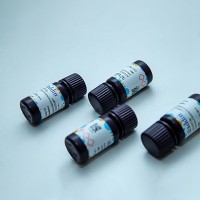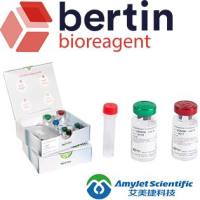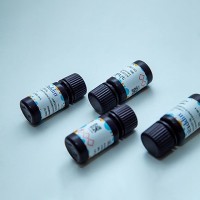Purification of Antiserum or Ascites by Protein A/G Chromatography
互联网
1、Required Materials and Equipment
(1) Protein A or G agarose gel column (10 ml or 5 ml of packed beads; see guidelines below for choice of protein A or protein G)
(2) Ice-cold Tris-buffered saline (TBS). See recipe below
(3) 5% sodium azide solution
(4) Neutralization Buffer (NB). See recipe below
(5) Elution Buffers (pH 2.7 and pH 1.9). See recipes below
(6) Centrifuge tubes and microcentrifuge tubes
(7) Preparative centrifuge and microcentrifuge
(8) pH strips
(9) Microtiter plate reader with 600 nm filter
(10) Glass Columns
2、Guidelines for Choosing Protein A Agarose or Protein G Agarose
(1) Antibodies bind with different affinities to protein A and protein G conjugated agaroses. Use the chart below to choose the best affinity agarose for your antibody
Species and Type of Antibody | Agarose |
| Rabbit IgG | Protein A or Protein G |
| Mouse IgG1 | Protein G |
| Mouse IgG2 | Protein A or Protein G |
| Mouse IgG3 | Protein G |
| Sheep IgG | Protein G but binds weakly |
| Rat IgG | Protein G but binds weakly |
| Guinea Pig IgG | Protein A |
| Dog IgG | Protein A |
| Goat IgG | Protein G |
| Pig IgG | Protein A |
(2) Buffer Preparation
To prepare 1 liter of TBS (50 mM Tris-HCl, pH 7.4; 150 mM NaCl; 0.05% sodium azide) add the following to 800ml of distilled water:
Ⅰ6.06 g of Tris base
Ⅱ8.77 g of NaCl
Ⅲ 10ml of 5% sodium azide stock solution (Do not add if the antibody will used in assays of cellular response or function.)
Ⅳ Mix well and adjust the pH to 7.4 with 5 N HCl. Bring the volume up to 1 L with distilled water and recheck the pH after chilling on ice.
(3) To prepare 100 ml of NB (1 M Tris-HCl, pH 8.0; 1.5 M NaCl; 1mM EDTA; 0.5% sodium azide), add the following to 80 ml of distilled water
Ⅰ12.1 g of Tris base
Ⅱ 8.7 g of NaCl
Ⅲ 200 microliters of 0.5M EDTA
Ⅳ 10 ml of 5% sodium azide stock solution (Do not add if the antibody will used in assays of cellular response or function.
Ⅴ Mix thoroughly and adjust the pH to 8.0 with 5 N HCl. Add distilled water to obtain a final volume of 100 ml. The NaCl and EDTA are added to prevent aggregation of the antibodies and loss of biological activity.
(4) To prepare 100 ml of Elution Buffer pH 2.7 (50 mM Glycine-HCl, pH 2.7), add the following to 80 ml of distilled water
0.38 g of Glycine mix thoroughly and adjust the pH to 2.7 with 5N HCl. Add distilled water to a final volume of 100ml.
(5) To prepare 100 ml of Elution Buffer pH 1.9 (50 mM Glycine-HCl, pH 1.9), add the following to 80 ml of distilled water
0.38 g of Glycine mix thoroughly and adjust the pH to 1.9 with 5 N HCl. Add distilled water to a final volume of 100 ml.
3、Procedure
(1) Section I Preparation of a Protein A Agarose or Protein G Agarose Affinity Column
Typically, columns containing 5 ml or 10 ml of packed protein A/G Agarose are prepared. The size of the column is determined by the binding capacity of protein A/G and the amount of antiserum that must be processed. Protein A and protein G bind about 20 mg of IgG per ml of conjugated agarose. Therefore, the binding capacity of a 10 ml (5 ml) column is 200 mg (100 mg) of IgG. A high-titer rabbit antiserum has roughly 5 mg/ml of IgG, mouse ascites has roughly 10 mg/ml of IgG, and goat or sheep antiserum has roughly 20 mg/ml of IgG. Use the guidelines below to choose a column size to avoid exceeding the capacity of the column. Do not exceed 90% of the binding capacity of the column.
10 ml Bead Volume Protein A/G Affinity Column
| Source of Antibody | Concentration | Volume for Capacity | Volume for 90% Capacity |
| Rabbit Antiserum | 5 mg/ml | 40 ml | 36 ml |
| Mouse Ascites | 10 mg/ml | 20 ml | 18 ml |
| Goat/Sheep Antiserum | 20 mg/ml | 10 ml | 9 ml |
5 ml Bead Volume Protein A/G Affinity Column
| Source of Antibody | Concentration | Volume for Capacity | Volume for 90% Capacity |
| Rabbit Antiserum | 5 mg/ml | 20 ml | 18 ml |
| Mouse Ascites | 10 mg/ml | 10 ml | 9 ml |
| Goat/Sheep Antiserum | 20 mg/ml | 5 ml | 4.5 ml |
Pouring the Protein A/G Affinity Column
Ⅰa pipet to transfer the desired volume of a 50% protein A/G agarose slurry to a vacuum flask. Remember to transfer enough slurry to prepare a column with the desired bed volume and capacity.
ⅡPlace a stopper in the vacuum flask and apply vacuum for at least 15 minutes at room temperature. This step removes gas from the agarose and is necessary to prevent bubble formation in the column that would reduce the column's capacity and resolution.
Ⅲ While degassing the agarose, chill the TBS on ice. Prepare TBS without azide for antibodies that will be used in vivo or in cellular assays. TBS is used to equilibrate and wash the protein A/G column.
Ⅳ Slowly add the degassed protein A/G agarose to a glass column, e.g., a Biorad Econo Column, using a wide bore pipet to prevent rupturing the beads.
Ⅴ Pack the column at a flow rate of about 1-2 ml per min. Do not let the column run dry! Flow rate may be controlled by using a Mariotte flask or pump.
Ⅵ Wash the column with 10 bed volumes of ice-cold TBS. This step chills the column, which reduces nonspecific binding of proteins and slows the metabolism of any remaining viable microbes. <
(2) Section II. Preparation of Antiserum or Ascites for Affinity Chromatography
Throughout this section, "antiserum" refers to antiserum or ascites.
ⅠThaw the antiserum in ice water or the refrigerator overnight to prevent aggregation of proteins. Any protein aggregate that forms during thawing may be dissolved by briefly warming the thawed antiserum to 37.
ⅡAdd sodium azide to a final concentration of 0.05%, which is a 1:100 dilution of a 5% stock solution.
Ⅲ CAUTION: Since sodium azide is toxic, wear gloves and handle the stock solution with care.
Ⅳ Clarify the antiserum by centrifugation at 15,000 x g for 5 minutes at 4. This step is performed to sediment aggregates of denatured protein and lipid; it is an important step because it removes material that can foul and block the column.
Ⅴ Remove the clarified antiserum that lies between the floating lipid and the pellet. Additional filtration may be required to remove residual lipid.
(3)Section III. Affinity Chromatography Using Protein A/G Agarose
ⅠSave a 500 microliter sample of the clarified antiserum for testing along side the purified IgG because the antibody may be acid labile.
ⅡAdd the clarified antiserum to the column at a flow rate of 2 ml per minute. (Calibrate the flow rate using a 15 ml conical centrifuge tube as the receiving vessel. Adjust the stopcock on the column to give a flow of 2 ml per minute. Do not exceed a flow rate of 2 ml per minute.) Pass the antiserum through the column twice and save the flow through in case the antibody did not bind to the column.
Ⅲ Wash the column with a volume of TBS equal to 10 fold the volume of antiserum loaded on the column. For example, if 30 ml of antiserum were loaded on the column, wash with 300 ml of PBS. Save the wash in case the antibody was eluted.
Ⅳ After washing the column, collect a 20 microliter fraction and test for protein by adding it to 180 microliters of Coomassie Blue reagent to test for protein. If the sample turns blue, wash the column with an additional 50 ml of TBS and repeat the analysis for protein.
Ⅴ Prepare 1.5 ml microcentrifuge tubes for the collection of eluted antibody. Obtain one tube for each ml of antiserum plus five extra 1.5 ml tubes. Add 100 microliters of Neutralization Buffer (NB) to each tube. Note that IgG may be eluted from protein A/G agarose by a change in temperature, ionic strength, and/or pH. All of these conditions affect the binding between the charged amino acids of protein A/G and the Fc region of the IgG heavy chain. When eluting with acidic buffer, the acid must be neutralized as quickly as possible to prevent denaturation of the IgG.
Ⅵ Once the column has been washed, drain the TBS from the column bed to avoid unnecessary dilution of the Elution Buffer. Do not let the column stand dry.
Ⅶ Gently add Elution Buffer pH 2.7 at room temperature to the column. Be careful not to disrupt the column bed. Use 15 ml of Elution Buffer pH 2.7 if less than 20 ml of antiserum was loaded. Use 20 ml of Elution Buffer pH 2.7 if 20-30 ml of antiserum was loaded. Use 25 ml of Elution Buffer pH 2.7 if 30-36 ml of antiserum was loaded. Note that these volumes are guidelines and Elution Buffer muse be added until all protein has been eluted from the column.
Ⅷ Collect roughly 1 ml fractions in the tubes prepared in step 5 above. Mix each fraction immediately and place on ice before collecting the next fraction. Neutralizing the acid pH prevents denaturation of the antibodies and loss of biological activity.
Ⅸ Add 10 ml of Elution Buffer pH 1.9 at room temperature to the column; be careful not to disrupt the column bed. Collect, mix, and save fractions as described in step 8 above.
Ⅹ Remove a 20 microliter sample of each fraction and add to 180 microliters of Coomassie Blue reagent in a microtiter plate to monitor protein elution. Continue to collect fractions until the color drops to or just below background.
Ⅺ Read the microtiter plate at 600 nm and combine all fractions with an absorbance greater than or equal to 0.2 above background at 600 nm. For example, if the background is 0.18, combine all fractions with an absorbance greater than 0.38.
Ⅻ Once the absorbance has dropped below 0.2, wash the column with 200 ml of ice-cold TBS with 0.05% sodium azide.
ⅩⅢ Store the column at 2-8℃.
ⅩⅣ Use pH paper to check the pH of the combined fractions. If the pH is less than 7.0, use NB to adjust the pH to approximately 7.4.
ⅩⅤ Use the Bradford Assay with IgG as a standard, to determine the concentration of the antibody in the combined fractions. Add glycerol to 10% of the total volume if the antibody concentration of the combined fractions is less than 0.5 mg/ml.
ⅩⅥ Store the purified antibody at 2-8℃.






